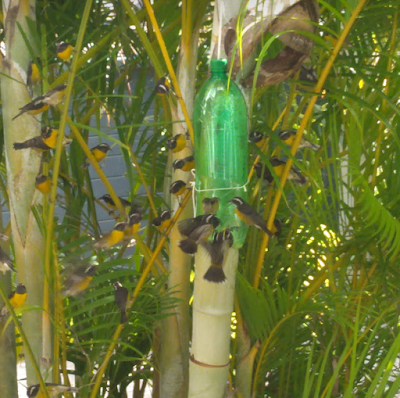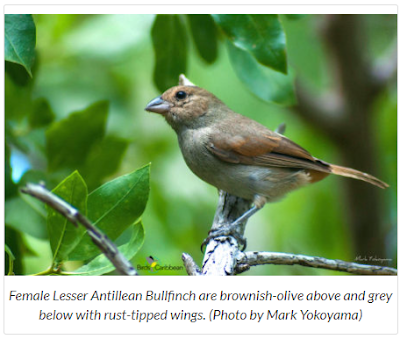Reconnect with Nature
Next to her front patio, a friend of mine in the Lesser Antilles has a beautiful garden with lots of local flowering plants, bushes, and palm trees. I really enjoy going over there and admiring her garden and reconnecting with nature. A couple of weeks ago, I stopped by her home for a chat. While we chatted, there was quite a lot of activity behind me. Birds were chirping and fluttering about in the greenery. I remarked, how tame the birds seemed and that they were not scared of me at all. In passing, she said that this was normal and that local birds were always like that.
When I got home, I shared this with my husband. His response was, “did you take any pictures of the birds?” - “Sorry, no, I did not bring my phone with me”.
A few days later I stopped by for another little visit. This time I was equipped with my phone. When I arrived, I was surprised, at how quiet it was compared to the previous visit. I mentioned to my friend how disappointed my husband had been, that I did not take any photos of the bird activity during my last visit. My friend laughed. “Oh, It is so quiet here today because I ran out of sugar.” – “What?!”
She confided in me, that first thing in the morning she fills up the bird feeder with sugar, which attracts the birds.
I wanted to try our luck at attracting, feeding, and observing these beautiful birds too. Instead of using a feeder bowl, I filled a large seashell (that I kept from the previous night’s Coquilles Saint Jacques appetizer) with sugar and set it on the patio.
Meet Our New Friends
It took about a day before my sugar-filled shell attracted any birds. But as soon as the first bird discovered the treats I had left out, the word got out in the local bird community. We were amazed at the number of birds drawn to the feeder.
We discovered that the birds would perch on the shell as they were feeding, causing the shell to rotate and spin. Some of the sugar would spill onto the tiles of the patio. You can see by the picture above that none of the spilled sugar is going to waste. The birds feed either out of the shell or eat the spilled sugar on the ground.
One negative aspect of the shell sugar dispenser, though, is when it rains. The shell quickly fills with rainwater. The sugar then turns into a sticky nectar, which in turn attracts ants.
Making a Bird Feeder
In order to not feed and attract ants, I decided to make a hanging bird feeder by repurposing a plastic soft drink bottle. Several centimeters from the bottom, I cut out a square piece of plastic into the side of the bottle. It was large enough for the birds to climb in and out, but small enough to keep most of the rain out.
With a Philips head screwdriver, I poked a hole into the bottle cap, threaded a string through the cap, and secured it with a knot tied over a toothpick. This way, I could hang the feeder from our patio divider or one of the palm trees adjacent to the patio.
I repurposed the elastic from used disposable surgical face masks to secure the bottle against the stem of the palm tree. This way, the bird feeder would not swing in the wind, rotate the opening against the face of the stem, and prevent any sugar from spilling out in a wind gust. Once secured, I filled the bottom with a few tablespoons of sugar, and eagerly awaited our new guests.
Again, it took a few hours for the birds to discover this new feeder.
Birds Attracted by our Bird Feeder
We have become quite fascinated by these little birds and it gives us a lot of joy observing them. To learn more about them, I discovered that this bird species is called Banana Quit (Coereba Flaveola). These birds are native to tropical South America, Mexico, and the Caribbean. The Banana Quit has a stocky, curved beak adapted to taking nectar from flowers.
It must be noted that the Banana Quit has the remarkable ability to adapt to human surroundings. They often visit gardens and can become very tame. It has been nicknamed Sugar Bird, due to its fondness for granulated sugar.
When I would first put sugar out for the Sugar Birds, a Tablespoon full of sugar would last about one day. However, since these birds are accustomed to us, more and more birds arrive to feed on our patio and the sugar vanishes quite quickly.
The other morning, when I went outside to hang up our washing on the patio to dry naturally in the sun, the bird feeder was empty once again. I spied one brave little Sugar Bird on a palm fond close to my laundry rack. This little one became quite animated, agitated, and very vocal. It appeared he was scolding me to get a move on to go, get my sugar jar, and fill up the bird feeder.
The little agitated Sugar Bird even flew from the palm fond and landed on my laundry rack right next to me, chirping and scolding away at me. I had to laugh at his antics. It reminded me of the antics and little meltdown of the current ATP tennis number 1 at the 2022 Australian Open. In his honor, I named my little bird: Daniil. I felt like the little Sugar Bird was saying (and I loosely quote Daniil Medvedev here): “Oh my god, you are so bad! … How can you be so bad… Look at me! I’m talking to you! … If you do not [fill up the sugar right now], you are – how can I say it – a SMALL CAT!!” (My imagination carried me away and I really had to laugh at these antics.)
To stop this abuse by the little bird, I obligingly went to the kitchen, grabbed the sugar jar, and quickly filled up the bird feeder. Almost immediately, the local Sugar Bird community descended on our feeder for a little feast. How many birds do you see in this picture?
It is funny to observe that these birds definitely have a pecking order. Look at how they are assembled on the palm fonds. They will give their fellow birds just so long to feed. Then the next bird will fly up to the opening, nudge the glutton bird that takes longer than the allotted feeding quantity and time, peck him on his back to chase him away, and then take his place to feed.
Lesser Antillean Bullfinches
Once in a while, I have observed that other birds will feed at our feeder, mostly they are Lesser Antillean Bullfinches. In the foreground in the photo below, you will see a female Lesser Antillean Bullfinch (Loxigilla Noctis). She is the one with the brown body. If the Bullfinches arrive first, they will defend their position on the feeder and peck at the Sugar Birds, to chase them away. However, that does not last too long, as the Sugar Birds outnumber the Bullfinches. Then the Sugar Birds seem to make a coordinated effort and attack the finches to chase them away.
I have yet to observe that the finches (a black-bodied and red-throated male and a brown-bodied female) would muscle in on the Sugar Birds, though the former birds are slightly larger in size than the latter.
When I shared a video of the Banana Quits feeding on our patio with my cousin living in Germany, she thought that they were Hummingbirds. My research shows that the Banana Quit must always perch when it is feeding. It is not able to hover like a Hummingbird.
Hummingbirds
By comparison, Hummingbirds (we have those here too) drink the nectar they find in certain flowers. While living in California, we had a special Hummingbird feeder that dispensed sugar water so we could observe the hummingbirds. Unlike the Banana Quit, the Hummingbird or Colibri has a long, flexible beak. They drink with their long tongues, licking up (or slurping up) the nectar quickly. Hummingbirds very rarely sit while feeding, instead, they hover near the flower or feeder. In the English language, hummingbirds got their name because their flapping wings beat so fast making a high-frequency humming sound.
Hummingbirds are native to the Americas and can be found as far north as Alaska and south to Tierra del Fuego (the southern tip of South America). They are migratory birds, some traveling up to 2,000 miles (or over 3,200 kilometers) twice a year. Amazingly, they are able to not only hover, but they can fly forward, backward, and even upside down!
You may wonder, why the Hummingbirds have not come to feed on the sugary nectar after our sugar bowl was doused with rain. I believe, that the neutral color of the scallop shell just did not attract the Hummingbirds. You see, Hummingbirds are typically attracted to bright colors, especially the color red.
I invite you to take some time, observe nature and the birds that frequent your backyard and neighborhood, wherever it may be. It is a beautiful way to connect with nature.
Happy Birdwatching
~~~~~~~~~~~~~~~~~~~~~

















Love the article. There are so many of natures gifts. We need to appreciate them. We must not loose our values in the hectic day to day concerns.
ReplyDeleteThank you for reminding us.
CARLOS
Thank you for your kind words, Carlos. Yes, you can't imagine the sheer joy we've been experiencing just by observing nature and its beautiful creatures around us. I enjoy sharing them with you and my readers.
DeleteGreat excerpt about the birds and their love for sugar. I guess sugar is universally loved no matter how much we try to stay away. They’d probably go crazy for something like maple syrup.
ReplyDeleteSam